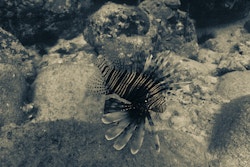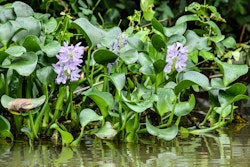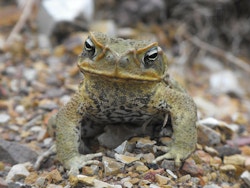Invasive Species, a worldwide issue
Invasive species, in most of the case resulting in a voluntary or accidental human introduction, can be found in many places across our planet. From lionfishes in Guadeloupe to the invasive mangroves in Pearl Harbor, this phenomenon documented by our crew could be overlooked if it was not one of the leading cause of biodiversity loss in the world. Let’s discover more with Katia Nicolet, marine biologist onboard Energy Observer.

Lionfish in the Caribbean
An invasive species is an organism introduced outside of its natural distribution and that negatively impacts its new environment. These species may be plants, animals, fungi and microbes. Not all introduced species become invasive, however. Some do not adapt to their new habitat and disappear, others survive but their presence does not modify the ecosystem. Invasive species, though, threaten biodiversity and cause ecological, environmental and economic damage as a result of their expansion.
A human-facilitated introduction
While some organisms naturally disperse outside their range, humans have greatly increased the rate, scale and geographic range of invasion. This human-facilitated introduction can be voluntary or accidental. Since humans have explored new frontiers, they have brought animal and plant species with them (dogs, cats, pigs, goats, cows, corn, wheat, vegetables, ornamental flowers, etc.) and some, like feral pigs and domestic cats have caused catastrophic damage to their new habitats. Rats and other rodents are an example of accidental introduction. These often boarded ships, at the great displeasure of the crew, and landed half a world away at the next port of call. The brown (or common) rat is thought to have originated in northern China, but has now spread to all continents except Antarctica!
The United Nations consider that invasive species are one of the leading cause of biodiversity loss in the world. Furthermore, they estimate that these species cost the global economy some 1 400 billion dollars each year.

Invasive plant, Guadeloupe
Land example: Cane Toad, one of the worst invasive species
The cane toad is a large poisonous amphibian from South America, which has been voluntarily introduced to many countries (USA, Hawaii, Guam, Philippines, Caribbean, Australia and elsewhere) and is now considered to be one of the worst invasive species in the world. Cane toads eat mostly insects and were introduced as a biocontrol of agricultural pests. The hope was that they would eat cane beetles, which feed from the roots of sugarcane and destroy cultures. In 1935, the Australian government released 2 400 individuals in north Queensland. Turns out, they do not eat cane beetles (but pretty much anything else) and, without natural predators, are now million strong and dispersed at a speed of 40 to 60 km per year through all of north Australia.
The reason for their rapid dispersal is their toxicity. Cane toads secrete a poison (called bufotoxin) from glands behind the head. This poison affects the heart and is so potent that it will kill any animal that bites, licks or eats the toad. To make matter worse, their eggs and tadpoles are also poisonous! In Australia, they have caused the decline and extinction of several native predator species, including the northern quoll.

Cane toad
Marine example: Lionfish, threat to the reef
Another well documented example of an invasive species is the Lionfish. This venomous reef fish is brightly coloured with red, white and black bands, which make it very attractive to the eye and a beautiful addition to any aquarium. Its ferocious appetite will however be the end of all other species kept in its tank, which probably explains why this animal is thought to have been released in the wild by unhappy aquarium enthusiasts. Lionfish are native to the Pacific, the Indian Ocean and the Red Sea, but they are now found in the Atlantic, the Gulf of Mexico, the Caribbean and the Mediterranean Sea.

Lionfish in the Caribbean
Their rapid spread can, again, be explained by their lake of natural predators outside of their natural range and their venomous spines making them uneatable and dangerous to most species. Worst of all, they are voracious and eat an incredible amount of small and juvenile fishes, invertebrates and mollusks. One research found up to six different species of prey in one stomach, and another study discovered that a single lionfish can reduce recruitment of native fish on a reef by 80%! While killing and reducing the numbers of small fish, they also impact large predators like snappers and groupers by consuming their natural prey.
Fighting back: the Macquarie Island Pest Eradication Project
The Macquarie Island Pest Eradication Project is the largest eradication program ever attempted for rodents and has been declared successful in 2014 after 7 years of intense work. Macquarie Island lies halfway between Australia and Antarctica and supports a unique wildlife including elephant seals, fur seals, penguins and many other seabirds. This large, 34km-long by 5km-wide, island was infested by introduced rabbits, rats and mice that devastated the vegetation, caused severe erosion and preyed on the eggs and chicks of native birds.
In 2007, the Australian government funded a 25-million-dollar project that would last 7 years and successfully eradicate all pests. The project included various phases, with the release of toxic baits by helicopter and the introduction of a virus targeting only rabbits. Once the rodent population dropped between 80 and 90%, the remaining individuals were tracked on the entire island by teams of trackers and their hunting dogs. These dedicated men, women and dogs scouted the island day and night, covering a total of 92 000 km in the span of two years, in some of the harshest conditions on the planet.
Considering the ecological damage invasive species cause and the economic impact of their eradication, the best strategy remains to avoid the introduction of new species... and let nature takes its course!